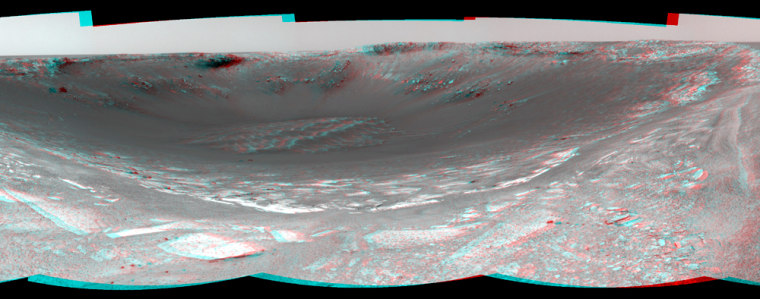After more than a month of Martian trekking, NASA's Opportunity rover has reached the rim of Endurance Crater and sent back an awe-inspiring panorama of the 430-foot-wide (130-meter-wide) gulf.
A stereo image of the scene was posted Monday on NASA's Web portal for the Mars missions, managed by the Jet Propulsion Laboratory in Pasadena, Calif.
Opportunity's arrival at the crater's edge on Friday represented the climax of a 2,600-foot (780-meter) odyssey that took the rover from its landing site in Eagle Crater, which is only about a fifth the size of Endurance Crater.
Both craters lie within an Oklahoma-sized plain called Meridiani Planum, which scientists suspect was once at the bottom of a salty sea, back when Mars was warmer, wetter and perhaps more hospitable to life. The suspicions were supported by evidence gleaned from Eagle Crater's exposed bedrock, and close study of Endurance Crater could add to those findings.
Promise and peril
Endurance Crater is about 82 feet (25 meters) deep — much deeper than Eagle Crater — and that means Endurance's bedrock could provide much more information about how long liquid water may have existed on a planet that is now cold, dry and barren.
"The science team is still chewing on a lot of the data that they're seeing," mission manager Matt Wallace told MSNBC.com. "There clearly are a lot of interesting science targets inside this crater — variations in the rock structure. The science team is excited about that."
But the newly released panorama also shows that it won't be easy for Opportunity to make its way down over the crater's edge. Wallace said the slopes of the crater's interior appeared to be "15 to 20 degrees, much higher than that in some places, but not much lower than that."
At that kind of slope, the rover's wheels would encounter significant slippage, Wallace said. "While we might be able to get down into the crater, we may or may not be able to get back out," he said.
Over the next couple of weeks, Opportunity will be sent all the way around the rim to take pictures and analyze the soil and rocks. "We may look for some locations where we can dip a toe in and get up a little bit closer to some of the formations close to the crater rim," Wallace said.
More images and data will be released at the mission team's weekly news briefing Thursday.
Following the water
The main mission for Opportunity — and for the Spirit rover, its twin on the opposite side of the planet — is to determine whether Mars could have had liquid water long enough for life to develop. Both rovers landed in January and have completed their 90-day primary missions, which were budgeted at $820 million. Another $15 million has been allocated for a mission extension through September.
Spirit is in the middle of its own trek within the 95-mile-wide (145-kilometer-wide) Gusev Crater, heading from Bonneville Crater to the Columbia Hills. The rover has found geologic signs of ancient liquid water, but not in the abundance found by Opportunity.
Late last week, Spirit spun one if its six wheels to dig a trench at a spot called "MayFly," then used the scientific instruments on its robotic arm to analyze the exposed subsurface soil.
Over the weekend, the Spirit rover team "got back on their horse and started riding at full speed again," Wallace said.
During the Martian day that ended Monday, Spirit set a new personal best of 303 feet (92.4 meters) for daily travel, improving on last week's mark, Wallace said. But even at its current pace, Spirit will require well more than a month to reach the base of the Columbia Hills. Opportunity still holds the all-time rover record, with a one-day jaunt of 463 feet (141 meters) over easier terrain.
